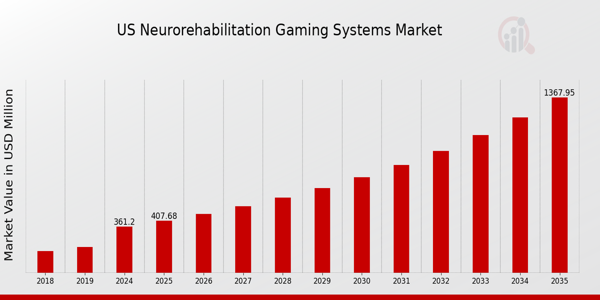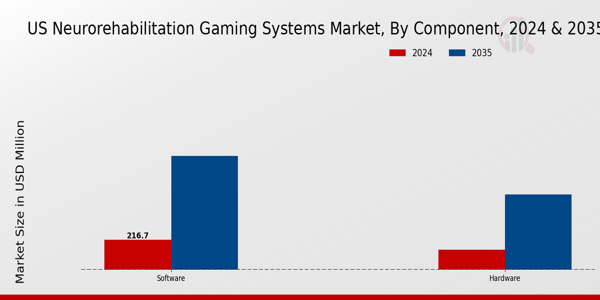US Neurorehabilitation Gaming Systems Market Overview
As per MRFR analysis, the US Neurorehabilitation Gaming Systems Market Size was estimated at 319.2 (USD Million) in 2023. The US Neurorehabilitation Gaming Systems Market Industry is expected to grow from 361.2 (USD Million) in 2024 to 1,368 (USD Million) by 2035.
The US Neurorehabilitation Gaming Systems Market CAGR (growth rate) is expected to be around 12.869% during the forecast period (2025 - 2035).
Key US Neurorehabilitation Gaming Systems Market Trends Highlighted
The US Neurorehabilitation Gaming Systems Market is witnessing several significant trends driven by increasing demand for innovative therapeutic solutions. The rising prevalence of neurological disorders, such as stroke and traumatic brain injuries, is a key market driver, prompting healthcare providers to seek effective rehabilitation methods.
Neurorehabilitation gaming systems, which incorporate engaging gameplay, have emerged as a novel approach to enhance patient participation and motivation during recovery. This trend is particularly relevant in the US, where the Centers for Disease Control and Prevention emphasizes the need for improved rehabilitation strategies.
Opportunities to be explored in this market include the development of personalized gaming experiences that adapt to individual patient needs and progress. With advancements in technology, such as virtual reality and artificial intelligence, there is potential for creating more immersive and tailored rehabilitation environments.
These innovations can support clinicians in monitoring patient progress more effectively, which aligns with the growing focus on data-driven healthcare solutions in the US. In recent times, the integration of telehealth with neurorehabilitation gaming systems has gained traction.
This trend allows patients to participate in therapy sessions from home, breaking geographical barriers to access care. As the US healthcare system shifts towards more patient-centric approaches, the combination of telehealth and gaming systems can offer a more flexible and convenient solution for patients and providers alike.
The increasing interest and investment in this area suggest a promising future for neurorehabilitation gaming systems in the US market.

Source: Primary Research, Secondary Research, MRFR Database and Analyst Review
US Neurorehabilitation Gaming Systems Market Drivers
Increasing Focus on Rehabilitation Technologies
The increased focus on integrating advanced technologies into rehabilitation practices significantly impacts the US Neurorehabilitation Gaming Systems Market Industry. Research indicates that the United States has witnessed a growth in the number of rehabilitation centers adopting innovative therapies.
As per the American Physical Therapy Association, more than 30% of rehabilitation facilities are now integrating technology-based therapies. This shift is spurred by a growing acknowledgment of the benefits that automation and computerized systems can bring to patient recovery.
Moreover, leading organizations like the National Institutes of Health are supporting this transition through funding and initiatives aimed at enhancing neurorehabilitation practices, thereby fostering an environment ripe for the growth of neurorehabilitation gaming systems, which focus on patient engagement and improved outcomes.
This ongoing trend not only boosts the demand for gaming systems but also aligns with broader national efforts to enhance recovery practices across diverse demographics.
Rising Incidence of Neurological Disorders
The increasing prevalence of neurological illnesses in the United States is a major driver of the US Neurorehabilitation Gaming Systems Market Industry. According to the Centers for Disease Control and Prevention, over 795,000 people in the United States have a stroke each year, increasing the demand for efficient rehabilitation methods.
With the American Stroke Association estimating a 20% rise in stroke survivors by 2030, the need for accessible neurorehabilitation treatments grows. This dire need compels healthcare providers to seek innovative solutions, such as gaming systems that offer engaging therapy.
Additionally, organizations like the American Academy of Neurology are actively promoting novel rehabilitation technologies, thus creating opportunities for market expansion.
Increased Investment in Research and Development
There has been a substantial increase in investment towards Research and Development (R&D) in the neurorehabilitation sector, further propelling the US Neurorehabilitation Gaming Systems Market Industry. In recent years, government funding for neurorehabilitation technologies, particularly through programs like the National Institutes of Health's Brain Research through Advancing Innovative Neurotechnologies Initiative, has seen allocations exceeding $30 million annually.
This strong backing provides researchers and companies with the resources necessary to develop and test novel neurorehabilitation gaming systems that enhance patient recovery experiences. Additionally, academic partnerships with tech firms are expected to yield innovative solutions tailored for diverse patient populations which reaffirms the importance of R&D investment in successful market growth.
Growing Awareness and Acceptance of Gamified Therapy
The growing awareness and acceptance of gamified therapy in rehabilitation practices in the United States plays a pivotal role in the growth of the US Neurorehabilitation Gaming Systems Market Industry. Consumer awareness campaigns and endorsements by psychological and physical therapy organizations have helped people recognize the benefits of gamified therapy in improving motivation and outcomes.
For instance, the American Psychological Association has been instrumental in disseminating information regarding the efficacy of game-based therapies. Reports show around 40% of therapists in the US are now regularly incorporating gaming elements into their therapy approaches.
This increasing acceptance among both practitioners and patients underscores the potential for sustained demand and growth within the neurorehabilitation segment, as more individuals seek advanced, engaging therapy options.
US Neurorehabilitation Gaming Systems Market Segment Insights
Neurorehabilitation Gaming Systems Market Component Insights
The US Neurorehabilitation Gaming Systems Market signifies a remarkable growth trajectory within the healthcare technology landscape, particularly influenced by advancements in its Component segment, which encompasses Hardware and Software. The transformation of rehabilitation practices through engaging gaming interactions reflects a pivotal shift towards patient-centric solutions.
As healthcare providers increasingly integrate gamification techniques in therapeutic settings, the demand for robust Hardware systems has surged, facilitating real-time feedback and active participation from patients. This Hardware aspect plays a crucial role in creating immersive environments, thereby enhancing recovery outcomes and boosting patient motivation.
Meanwhile, the Software segment is experiencing significant innovation, with various platforms tailored to cater to diverse therapeutic needs. This adaptability allows for customized rehabilitation programs, supporting individual progress and accommodating different levels of physical and cognitive impairments.
Moreover, the Software is critical for tracking patient data, providing healthcare professionals with essential insights into treatment effectiveness. The increasing focus on digital health solutions and remote rehabilitation, particularly in light of recent healthcare challenges, drives opportunities for both Components.
Furthermore, government support for technology-driven healthcare solutions fosters a favorable environment for growth, bolstering investment in Neurorehabilitation Gaming Systems. As a result, both Hardware and Software are vital to the sector, contributing to improved patient outcomes and reshaping the future of rehabilitation therapy in the US.
The convergence of technology and healthcare in this sector reflects broader trends in digital therapy and innovative treatment methodologies, enhancing access to rehabilitative resources nationwide.

Source: Primary Research, Secondary Research, MRFR Database and Analyst Review
Neurorehabilitation Gaming Systems Market Application Insights
The US Neurorehabilitation Gaming Systems Market is increasingly being categorized based on various applications, with key areas including Stroke, Parkinson's Disease, Multiple Sclerosis, and others playing instrumental roles in the market's growth. Stroke-related rehabilitation is crucial, given its vast patient demographic, often requiring innovative therapeutic solutions to enhance recovery.
Simultaneously, the management of Parkinson's Disease has witnessed significant advancements through gaming technologies, which have proven effective in improving motor skills and overall well-being. Multiple Sclerosis represents another important application due to the complex and varied nature of the disease that often necessitates engaging therapy methods to encourage patient participation.
The growing recognition of the therapeutic benefits of gamified rehabilitation reinforces the importance of these applications in the US Neurorehabilitation Gaming Systems Market, driving a shift from traditional methods to more interactive solutions. As rehabilitation continues to evolve, integrating technology with healthcare remains essential, pointing to a demanding landscape that seeks improved patient outcomes while fostering innovation within the industry.
Neurorehabilitation Gaming Systems Market Modality Insights
The US Neurorehabilitation Gaming Systems Market is categorized into different modalities that cater to varying patient needs and preferences. The PC modality has gained traction due to its ability to provide rich graphics and immersive experiences that enhance patient engagement during therapy sessions.
This modality often supports complex rehabilitation processes, making it a vital tool for clinicians aiming to improve patient outcomes. On the other hand, the Tablet and Smartphone modality is rapidly gaining popularity, especially because of its accessibility and convenience.
With a majority holding in the market, these devices allow patients to engage with rehabilitation gaming systems anytime and anywhere, fostering continuous practice outside of clinical settings. The portability of tablets and smartphones also enables easier integration into daily life, which can lead to increased compliance and motivation among patients.
This segmentation reflects an important trend towards personalized and accessible neurorehabilitation solutions, which are critical as the demand for effective rehabilitation therapies continues to grow in the US, driven by an aging population and rising incidences of neurological disorders.
US Neurorehabilitation Gaming Systems Market Key Players and Competitive Insights
The US Neurorehabilitation Gaming Systems Market has become increasingly dynamic and competitive due to the rising demand for innovative rehabilitation solutions that leverage gaming technologies. The integration of therapeutic approaches with interactive gaming systems has revolutionized patient rehabilitation, encouraging engagement and motivation among users.
As healthcare providers and institutions recognize the efficacy of gamified therapy, the competitive landscape has been shaped by several key players that continuously refine their offerings to enhance treatment outcomes. Factors such as technological advancements, demographic trends, and an increasing focus on personalized rehabilitation programs are driving competition.
The market is characterized by a blend of established healthcare companies and emerging startups, each vying for a share in the lucrative neurorehabilitation sector. MediTouch has established a solid presence in the US Neurorehabilitation Gaming Systems Market, primarily focusing on improving patient engagement through its advanced gaming platform.
The company’s strengths lie in its innovative technology and user-friendly interface that seamlessly blends rehabilitation exercises with interactive gaming mechanics. This approach not only aids in the physical recovery of patients but also addresses cognitive rehabilitation needs, thereby providing a comprehensive solution in neurorehabilitation.
MediTouch has effectively expanded its market reach through collaborations with healthcare facilities across the United States, enhancing its credibility and visibility in the industry. These strategic partnerships have enabled MediTouch to provide tailored solutions to diverse patient demographics, strengthening its competitive position.
AlterG, on the other hand, has carved out a notable niche in the US Neurorehabilitation Gaming Systems Market with its unique approach to rehabilitation through its advanced technology in anti-gravity treadmills and gaming systems. The company focuses on offering high-quality products that assist patients in regaining mobility while minimizing the risk of injury.
AlterG's product lineup includes a variety of therapeutic devices designed to facilitate rehabilitation for a range of neurological conditions. This commitment to innovation positions AlterG as a leader in its field, particularly with its emphasis on evidence-based outcomes.
Moreover, AlterG has expanded its market influence through strategic mergers and acquisitions, allowing for broader distribution channels and enhanced technological capabilities. This proactive business strategy, combined with a commitment to improving patient outcomes, reinforces AlterG's reputation and presence in the US neurorehabilitation landscape.
Key Companies in the US Neurorehabilitation Gaming Systems Market Include
- Hewlett Packard Enterprise
US Neurorehabilitation Gaming Systems Market Industry Developments
The US Neurorehabilitation Gaming Systems Market is experiencing significant advancements and investments, reflecting a growing recognition of the effectiveness of gamified therapy for conditions like stroke and traumatic brain injuries. Companies such as MediTouch, AlterG, and Kinectic Vision are at the forefront, innovating in areas like motion tracking and virtual reality applications.
Recently, in August 2023, MindMotion secured funding to expand its neurorehabilitation solutions, enhancing patient engagement through immersive gaming experiences. GaitTronics also reported an increase in demand for its rehabilitation systems, driven by an aging population and a shift toward more interactive and engaging therapy methods.
In terms of market dynamics, Stryker has seen growth, bolstered by strategic partnerships aimed at integrating advanced technology in their rehabilitation devices. Moreover, NeuroRehab VR and Virtualware are gaining traction with their VR solutions, which have proven effective in patient recovery trajectories.
In the last few years, companies like Bioness have launched innovative products to provide enhanced therapy options, indicating a robust movement towards technology-enhanced rehabilitation processes in the US market, aligning with government initiatives aimed at increasing accessibility and efficiency in healthcare delivery.
Neurorehabilitation Gaming Systems Market Segmentation Insights
Neurorehabilitation Gaming Systems Market Component Outlook
Neurorehabilitation Gaming Systems Market Application Outlook
Neurorehabilitation Gaming Systems Market Modality Outlook
| Report Attribute/Metric |
Details |
| Market Size 2023 |
319.2(USD Million) |
| Market Size 2024 |
361.2(USD Million) |
| Market Size 2035 |
1368.0(USD Million) |
| Compound Annual Growth Rate (CAGR) |
12.869% (2025 - 2035) |
| Report Coverage |
Revenue Forecast, Competitive Landscape, Growth Factors, and Trends |
| Base Year |
2024 |
| Market Forecast Period |
2025 - 2035 |
| Historical Data |
2019 - 2024 |
| Market Forecast Units |
USD Million |
| Key Companies Profiled |
MediTouch, AlterG, Kinectic Vision, GaitTronics, MindMotion, Stryker, Rehab Robotics, NeuroRehab VR, Candoo, Virtualware, Medtronic, Hewlett Packard Enterprise, TheraGun, Yaskawa Electric, Bioness |
| Segments Covered |
Component, Application, Modality |
| Key Market Opportunities |
Growing demand for home rehabilitation, Integration of AI for personalized therapy, Expansion into pediatric rehabilitation market, Increasing partnerships with healthcare providers, Rising acceptance of gamification in therapy |
| Key Market Dynamics |
Technological advancements in gaming, Increasing prevalence of neurological disorders, Rising demand for personalized therapy, Growing aging population, Shift towards home-based rehabilitation |
| Countries Covered |
US |















